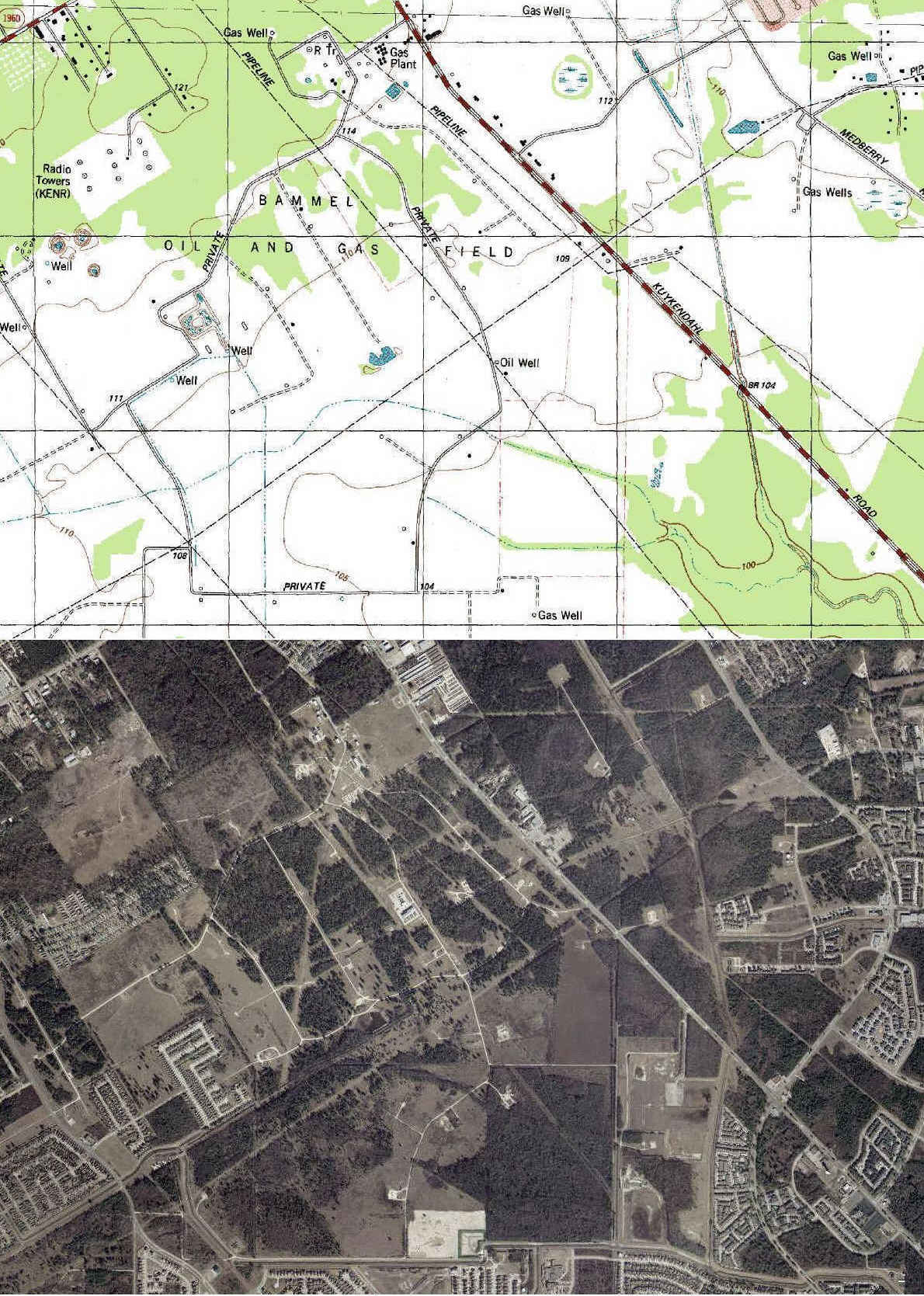Common Needs of Government & Industry
Increase ability to access information & respond to emergency
situations.
Standardize pipeline location data.
Protect confidential & proprietary business information.
Office of Pipeline Safety
![[Image]](bammel-hazard-maps.jpg)
5 September 2004. One of the Eyeball series.
Maps from Mapquest.com
Source of photos:
Terraserver-USA and
USGS Seamless.
http://news.tradingcharts.com/futures/0/0/58559300.html
Blast rocks Duke Energy's Liberty County, Texas, natural gas storage facility[Excerpts]
MOSS BLUFF, Texas, Aug 20, 2004 (Houston Chronicle - Knight Ridder/Tribune Business News via COMTEX) -- A voluntary evacuation order was lifted hours after natural gas from an underground storage cavern exploded near the Liberty-Chambers county line Thursday morning, sending flames 150 to 200 feet into the air and waking nearby residents. ...
The Houston area is home to more than a dozen natural gas storage operations, most of them in underground salt caverns. The closest is known as the Bammel Field, an underground formation with 120 billion cubic feet of gas capacity just 16 miles north of downtown Houston near Texas 249.
The storage facilities are used by companies for both long-term storage to supply the increased need for natural gas during the winter as well as short-term storage for trading on the spot and futures markets. Unlike underground storage facilities in rock formations, salt formations allow companies to inject and withdraw gas at much higher rates of speed.
Safety issues around natural gas and gas liquids pipelines generally get more attention that those at storage facilities, even though explosions for both kinds of facilities are uncommon. One of the better-known accidents involving a storage facility happened in 1992 near Brenham, where a natural gas liquids storage cavern was overfilled, allowing the formation of a gas vapor cloud that was ignited by a spark. Three people died as a result of the explosion.
The Texas Railroad Commission and National Transportation Safety Board determined safety equipment failed to operate properly and the company running it did not adequately monitor the cavern.
http://aapg.confex.com/aapg/da2004/techprogram/A86358.htm
Assessment of Casing Leaks from Wells in Oil and Gas Fields and Gas Storage Fields to Determine Environmental Hazards in Areas of Urban DevelopmentRufus LeBlanc, Jr and Victor T. Jones, III. Exploration Technologies, Inc, 3698 Westchase Dr, Houston, TX 77042, phone: 713-785-0393, fax: 713-785-1550, etimail@eti-geochemistry.com
From 1942 to 1945 there was a spectacular surface/subsurface blowout from a casing leak in an oil and gas well in Bammel Field, Harris County, Texas. The oil and gas from the well severely impacted the surrounding fresh water aquifers. The results of the blowout to the aquifers were investigated and documented by geologists with the USGS from 1942 to 1945. After depletion of the oil and gas reserves in the subsurface reservoirs, Bammel Field was converted to an underground natural gas storage field.
Because the Bammel blowout was so spectacular, it has served as a scapegoat for most of the reported cases of petroleum contamination in water wells in northern Harris County. Other cases of either chlorides, methane, or BTEX in the groundwater of MUD wells have been attributed to this incident. A detailed retrospective analysis of the Bammel blowout, in light of more recent knowledge, provides an excellent model of contamination of an aquifer by a defective oil and gas well. Five distinct time episodes have been recognized regarding aquifer responses from the incident.
There have been recent reported incidents of methane and BTEX in groundwater from MUD wells surrounding Bammel Gas Storage Field. Investigations to determine the cause have not been of sufficient depth or scope. Proper assessment of casing leaks always requires in-depth integrated investigations by health agency professionals, environmental engineers, petroleum geologists and petroleum engineers.
http://www.aep.com/newsroom/newsreleases/default.asp?dbcommand=displayrelease&ID=812
AEP COMPLETES PURCHASE OF HOUSTON PIPE LINE COMPANY FROM ENRON[Excerpt]
COLUMBUS, Ohio, June 1, 2001 - American Electric Power (NYSE: AEP) announced today it has completed its purchase of the stock of Houston Pipe Line Company (HPL), an intrastate natural gas pipeline subsidiary of Enron Corp. (NYSE: ENE). The transaction includes inventory and a 30-year pre-paid lease related to the operation of the Bammel Storage Facility. The $726.6 million for the transaction will be raised by issuing a non-controlling, preferred equity interest to private investors.
The purchase, announced Jan. 11, 2001, was completed following clearance from the Department of Justice under the Hart-Scott-Rodino Act. HPL owns, or leases, and operates one of the most extensive and flexible natural gas gathering, transportation and storage operations in Texas. HPL’s intrastate system includes more than 4,400 miles of pipe with capacity of approximately 2.4 billion cubic feet per day (Bcf/d) and the operation of the Bammel Storage Facility, one of the largest storage facilities in North America with a capacity of approximately 118 billion cubic feet and significant injection and withdrawal capacity.
http://www.aep.com/about/powerplants/default.htm
Gas StorageAEP has assembled a strong natural gas asset base in Texas, Louisiana, and the Gulf Coast through the addition of Houston Pipe Line Company (HPL) in 2001.
AEP has 128 billion cubic feet (Bcf) of total storage capacity at its facilities in Texas and Louisiana. The facilities allow HPL to handle fluctuations in daily receipt and delivery of gas, as well as contract storage for customers and standby supplies for emergency situations.
Bammel Gas Storage Facility, one of the largest underground reservoir storage fields in North America, is strategically located on the HPL system in Houston. Its capabilities include 118 Bcf total capacity, 1.3 Bcf/day withdrawal capacity, and 0.5 Bcf/day injection capacity. The Houston Ship Channel and Houston's gas distribution company are important markets. Proximity to the Katy Hub provides a wealth of interconnections.
Pipeline hazard maps are not available to the public.
http://www.npms.rspa.dot.gov/aboutnpms/workshops/NPMS_ChicagoWkshp1.pdfCommon Needs of Government & Industry
Increase ability to access information & respond to emergency situations.
Standardize pipeline location data.
Protect confidential & proprietary business information.Office of Pipeline Safety
![[Image]](bammel-hazard-maps.jpg)
|
 |
 |
 |
 |